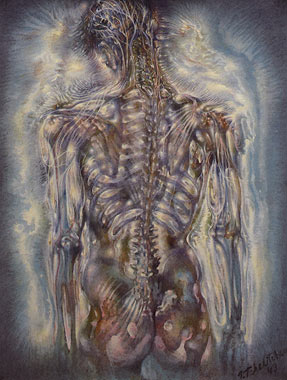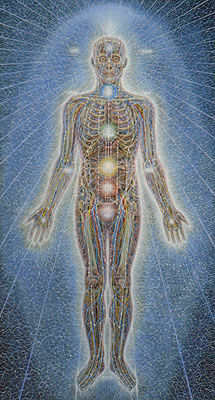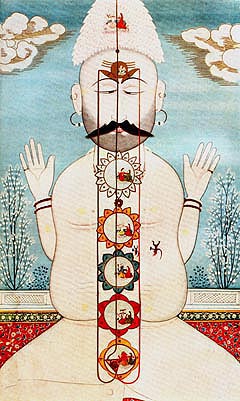A
few days ago I was forwarded a link to a forum in which fan of
"Fantastic Art" (now dog–breeder) Christian de Boeck put forward this
statement in lieu of an argument to defend the art of Ernst Fuchs
against criticisms I levelled against it (contra Fuchs):
"An
insane fatally flawed and poorly researched (it has more holes in it
than a Swiss cheese) essay attacking Fuchs imagery and alleged
religious views by Demetrios Vakras."
De
Boeck in the late 1990s established a fan–website for Fantastic Art and
Surrealism, which, hosted by Tripod, has disappeared. However, a page
in which he described his mission statement survives on the internet on
a site he designed for the "Society for Art of the Imagination". His
mission statement to establish a "Fantastic Art Centre" with himself as
self–appointed head has somehow made it onto the Wikipedia. (Refer
screenshot below)

De Boeck's mission statement included "Honorary Patrons". These patrons were Ernst Fuchs, Alex Grey, and a few others.
De Boeck discredited himself in 1999-2000 in the form of vitriolic criticisms levelled against Australian–German artist Wolfgang Grasse. The criticisms were made because flattering comparisons were made between the Christian–inspired art of Ernst Fuchs with the equally Christian–inspired art of Wolfgang Grasse by another fan (of "visionary" art), Damian Michaels. De Boeck's unfamiliarity with the Babylonian/Persian–derived elements which feature in Fuchs' art meant for him that Fuchs' art was without precedent. De Boeck's familiarity with the German–Flemish/Dutch models behind the motifs that appear in the art of Grasse, meant for him that Grasse was derivative. He derided Grasse, claiming him to be a "pasticheur." [MORE] The use by Fuchs of elements derived from Jan van Eyck did not diminish Fuchs in the opinion of de Boeck, but when elements of van Eyck appear in works by Grasse, they merely confirmed for him the derivative nature of the art of Grasse.
|
|
 Grasse armed his mediaeval motifs with 20th century armaments.
Grasse armed his mediaeval motifs with 20th century armaments.
Art by Wolfgang Grasse
Above: Saint George and the Atomic Dragon,
Wolfgang Grasse, acrylic and gold, 1979 (detail).
P. 52, LIFE & DEATH the metaphysical art of Wolfgang Grasse.
|
As an avowed promoter of original masters and not pasticheurs, one
would expect de Boeck to champion only original masters.
De Boeck's great problem: Alex Grey
Alex
Grey has become a celebrity. From junkies, US popular music bands, to
religious kooks, his art is celebrated as a window into the "soul" of
the cosmos. One cannot but wonder why. His works are (though
sometime–modified) forgeries of the work of Pavel Tchelitchev.
Sometimes these forgeries by Grey include elements taken from works by
another artist (for example, elements from the work of Ernst Fuchs).
| Pavel Tchelitchev's works, as in the example, right, form the basis of the works created by Alex Grey.
Tchelitchev
attempted to illustrate the "energy" coursing through the body, that
divides the living from the dead. He attempts via visual means to
elucidate a visual definition of being alive. It is an attempt to work
out the age–old question of what it is that makes us alive; whether
there is a soul, or "energy" that might be soul (ψυχή psyche) which can
define us. His works show the nervous system lighting with the impulses
of electric energy coursing through it as the brain sends commands to
various parts of the body.
One of his early works, Cache cache, exerted an influence even over my own art .
Pavel Tchelitchev died in 1957, 4 years after the birth of Grey.
|
 Fig. 1 The Golden Leaf, Pavel Feodorovitch Tchelitchev, gouache on paper, c. 1943. Pl. 62, Lincoln Kirstein, Tchelitchev. NJ. Crawford, New York
Fig. 1 The Golden Leaf, Pavel Feodorovitch Tchelitchev, gouache on paper, c. 1943. Pl. 62, Lincoln Kirstein, Tchelitchev. NJ. Crawford, New York
|
 Fig.
2 God of Rain, Pavel Feodorovitch Tchelitchev, gouache on paper, c.
1947. Pl. 64, Lincoln Kirstein, Tchelitchev. New Jersey State Museum,
gift of Lloyd B. Wescott.
Fig.
2 God of Rain, Pavel Feodorovitch Tchelitchev, gouache on paper, c.
1947. Pl. 64, Lincoln Kirstein, Tchelitchev. New Jersey State Museum,
gift of Lloyd B. Wescott.
|
 Fig.
3 Column of Fire (Spine), Pavel Feodorovitch Tchelitchev, oil on
canvas, c. 1948. Pl. 66, Lincoln Kirstein, Tchelitchev. Witney Museum
of American Art, New York, gift of Lincoln Kirstein.
Fig.
3 Column of Fire (Spine), Pavel Feodorovitch Tchelitchev, oil on
canvas, c. 1948. Pl. 66, Lincoln Kirstein, Tchelitchev. Witney Museum
of American Art, New York, gift of Lincoln Kirstein.
|
 Fig.
4 Vaso D'Oro (golden vessel/vase) , Pavel Feodorovitch Tchelitchev, oil
on canvas, c. 1955. Pl. 70, Lincoln Kirstein, Tchelitchev. Lincoln
Kirstein, New York.
Fig.
4 Vaso D'Oro (golden vessel/vase) , Pavel Feodorovitch Tchelitchev, oil
on canvas, c. 1955. Pl. 70, Lincoln Kirstein, Tchelitchev. Lincoln
Kirstein, New York.
|
Figures 1,2,3,4 are all paintings by Tchelitchev.
Although Tchelitchev's oeuvre was not limited to these works alone, it
is this series that Alex Grey has focused on to create his forgeries
with minor modifications. Fig. 4 by Tchelitchev takes on the appearance
of a vase. This would symbolically render the body a vessel (vase)
which holds the soul which is represented by the circles of energy.
Tchelitchev (Hardcover)
by Lincoln Kirstein (Author) List Price:
$60.00
Product Details
Hardcover: 184 pages
Publisher: Twelvetrees (September 1994)
Language: English
ISBN-10: 0942642406
ISBN-13: 978-0942642407
|
Below, figs. 5,6,7 are the forgeries
by Grey. Grey in fig.5 shows the human as a mindless marionette
controlled by some psychic energy over which the recipient has no
control. Grey has claimed Jungian impulses to guide his ideas. Like
others using Jung's theories, the unconscious impulses, it is claimed, lead him to
the works of others. These works happen to be images by Tchelitchev, which must
have been "uploaded" somehow into the ether. The "original element" in the Grey
image, fig. 6, is his inclusion of chakra circles.
As
always Jung is the refuge of cranks. As is evident Jung has provided
the means for Christian zealots to provide a seemingly secular
explanation for the means by which YHWH–cum–Jesus communicates with
them and the means by which he communicated with humanity (as written
in their holy books) in the past. This is uncannily close in concept to
the development by American Creationists of "Intelligent Design" as the
means by which Christian fantasy might cloak itself as respectable
science, and an alternative to "orthodox" scientific method.
|
A short note on Jung's "archetypes": In 19th century Germany, Plotinus, his Enneads,
and like-minded philosophers were very much in favour. The Germans
invented the misleading term "neoplatonism" to describe these
philosophers. Both Freud and Jung filched Plotinus' ideas on the soul
and its divisions, along with the Platonic basis for Plotinus, that an
abstraction, IDEA (usually mistranslated as "form" in English),
precedes the actual. This IDEA is the "archetype" or "primary
form" ascribed to ideas by Jung. The concern of Plotinus was the soul,
ψυχή, psyche, hence "psychology" - logic of the soul. A more complete
debunking of Freud and Jung lies outside the scope of this essay.
Amazon links: Plotinus' Enneads "Neoplatonism")
|
Below, figs. 5,6,7 are the Grey forgeries.
|
 Fig. 5 Painting, Alex Grey, oil, 1998. Metamorphosis, 50 contemporary surreal, fantastic and visionary artists, Johnny Beinart, publisher.
Fig. 5 Painting, Alex Grey, oil, 1998. Metamorphosis, 50 contemporary surreal, fantastic and visionary artists, Johnny Beinart, publisher.
|
 Fig. 6 Psychic Energy System, Alex Grey, oil (?), 1980–81. Illus., p. 36 Raw Vision (magazine), #26, Spring 1999.
Fig. 6 Psychic Energy System, Alex Grey, oil (?), 1980–81. Illus., p. 36 Raw Vision (magazine), #26, Spring 1999.
|
 Fig. 7 Dying, Alex Grey, oil, 1990. Metamorphosis, 50 contemporary surreal, fantastic and visionary artists, Johnny Beinart, publisher.
Fig. 7 Dying, Alex Grey, oil, 1990. Metamorphosis, 50 contemporary surreal, fantastic and visionary artists, Johnny Beinart, publisher.
|
 Fig. 8 Venus on the Island of Death, Ernst Fuchs, etching, 1976. P. 36, Ernst Fuchs, Der Feuerfuchs.
Fig. 8 Venus on the Island of Death, Ernst Fuchs, etching, 1976. P. 36, Ernst Fuchs, Der Feuerfuchs.
Grey
- without his being consciously
aware of it - must have tapped into Jung's ether to acquire elements from this picture kindly "uploaded" into
the ether by Fuchs. The eyes that appear in Grey's work, in fig. 7, are
taken from Fuchs and they are used to modify his figure taken from
Tchelitchev.
|
 Fig. 9
Fig. 9
http://en.wikipedia.org/wiki/Chakra
Chakra
From Wikipedia, the free encyclopedia (1/12/2008)
"Chakra (derived from the Sanskrit cakra? ∏≥Ëœ¢, Phonetic pronunciation
"chukr"…) is a Sanskrit word that translates as wheel or disc. Chakra
is a philosophical concept referring to wheel-like vortices which,
according to traditional Indian medicine, are believed to exist in the
surface of the etheric double of man.[1] The Chakras are said to be
"force centers" or whorls of energy permeating, from a point on the
physical body, the layers of the subtle bodies in an ever-increasing
fan-shaped formation".
|
 Fig.
10 A logarithmetic spiral network used by Escher to workout some of his
spiral designs. These designs seem to have infiltrated new–age
pseudo–Hindu designs of the later 20th century which appear to be
unattested to in earlier Indian art. Illus. 239, Bruno Ernst The Magic Mirror of M.C. Escher.
Fig.
10 A logarithmetic spiral network used by Escher to workout some of his
spiral designs. These designs seem to have infiltrated new–age
pseudo–Hindu designs of the later 20th century which appear to be
unattested to in earlier Indian art. Illus. 239, Bruno Ernst The Magic Mirror of M.C. Escher.
|
In
the past Grey acknowledged some association of his work to that by
Tchelitchev. The following are his responses to questions regarding his
art:
Alex:" …there
were artists who were motivated by surrealist and visionary intentions.
Pavel Tchelitchev, for example…Pavel Tchelitchev, who's most famous
painting, "Hide and Seek" is in the Museum of Modern Art, and
well-known to many psychedelic afficianados. It's a magnificient piece
done in 1940-41. He spent the remainder of his career, 1942-56 studying
the human anatomy, the subtle anatomy and spiritual networks of
energy.My work relates strongly to Tchelitchev. After acid trips, I started having visions of
glowing bodies with the acupuncture meridians and points, chakras and
auras all inter-relating. I started painting these images and a friend
of mine told me that Tchelitchev was doing this kind of thing forty
years ago. He was starting to do translucent bodies that I think were
influenced by "The Visible Man" or "Visible Woman" seen at the New York
World's Fair of 1939. Also, the use of X-rays must have influenced him
to envision a translucent body. Tchelitchev sometimes painted a glow
around the body, as well. He was well-versed in Pythagoreanism and
alchemy and was deeply into the occult.… My work is symbolic and
projects ideal archetypes…I think Tchelitchev's career will be
reassessed, and accorded more value. At any rate I see him as a
forefather to my artwork."
According to Grey he had visions of Tchetitchlev–like images under the influence of narcotics. He then considers "Whether he [Tchelitchev] ever took mescaline, I don't know. He was dead before much acid was available."
From "interview with alex grey" http://users.lycaeum.org/~maverick/grey.htm
To summarise Grey's claim: narcotics tune the mind to receiving transmissions from Jung's ether.
Tchelitchev's
works were continually exhibited during the middle part of the last
century. They were included in exhibitions in the US such as
"Surrealism Then and Now" and their accompanying catalogues: http://www.amazon.com/Surrealism-Then-Joseph-Randall-Shapiro/dp/B000M12DPW
. In 1964 there was a major exhibition of the works of Tchelitchev. It
too was accompanied with a catalogue which is still available. http://www.amazon.com/Pavel-Tchelitchew-Tchelitchev-Exhibition-Gallery/dp/B0013G9T20
. For some however, the Jungian ether makes more sense as the means by
which Grey acquired his "visions". Only those willing to believe and
those aided by medication can tune into it. This is a restating of the
Christian maxim that demands belief in god without reason or proofs.

As
Grey's own star has risen references to Tchelitchev are disappearing.
There is now an uncritical Wikipedia entry for Alex Grey (refer
screenshot above). There is no mention of Tchelitchev (various
spellings, eg "Tchelitchew", and partial spellings, eg "Tchel" returned
no results). The Wikipedia entry states that he specialises in
"spiritual" and " visionary art"; and more absurdly states that "[Grey]
is the Chair of Wisdom University's Sacred Art Department." By means of
circular reasoning Grey proves the existence of the ether of Jung and
seems to derive his income by helping others acquire such "insights."
In
the meantime, Tchelitchev's star has faded into a semi–obscurity. His
Wikipedia entry is comprised of only a few sentences (see screenshot
below). And, as Tchelitchev's star wanes, disingenuous theories
involving Jung and the ether are no longer needed to explain the
obvious debt owed by Grey to the work by an artist who seems to have
been forgotten.

Returning to de Boeck
De
Boeck was once, according to what he wrote, a Trappist monk (see the
wikipedia http://en.wikipedia.org/wiki/Trappist ) which confirms both
his particular brand of Christian delusion and the kind of art that he
believes to be great.
His ancestry, from the
region(s) of the "low-lands" (which comprise the modern region of
Flanders, France/Belgium/Holland), explain his ideas of Christianity
(which for him is Roman–Catholic).
One of his great ancestors is, Robert of Clari (from Picardy, refer
http://en.wikipedia.org/wiki/Picardie ) who was involved in the 1204
sack of the capital city of my ancestors, Byzantium.
Robert of Clari gave the following reason for the sack and destruction of the city of my ancestors:
"…they were worse than the Jews. And the bishops said that they would
asoil all those who should attack them, in the name of God…Then the
bishops commanded the pilgrims all to confess themselves well and to
take communion, and to not be afraid of attacking the Greeks, for they
were the enemies of God." p. 94 of the translation by Edgar Holmes
McNeal.
http://www.amazon.com/Conquest-Constantinople-Medieval-Reprints-Teaching/dp/0802078230
The Conquest of Constantinople (Medieval Academy Reprints for Teaching, 36)
ISBN: 0802078230
The same event was written on by one of my great ancestors, Niketas Choniates:
"More to blame were the learned and wise among men [Catholic priests
and monks], they who were faithful to their oaths, who loved the truth
and hated evil, who were more pious and just as scrupulous in keeping
the commandments of Christ than we Greeks… In truth they were exposed
as frauds. Seeking to avenge the Holy Sepulcher, they raged openly
against Christ and sinned by overturning the Cross with the cross they
bore on their backs, not even shuddering to trample on it for the sake
of a little gold and silver. By grasping pearls, they rejected Christ…"
sect. 576 (p.316) translated by Harry J. Magoulias.
http://www.amazon.com/City-Byzantium-Annals-Niketas-Choniates/dp/0814317642
O City of Byzantium, Annals of Niketas Choniates: Annals of Niketas Choniates (Byzantine Texts in Translation)
ISBN: 0814317642
There is a claim made by apologists of the Catholic faith that the 1204
sack was an act contrary to a Papal edict which forbade the crusaders
from harming Christians. However, these illformed Catholics of 1204
were guided by their acceptance as genuine the validity of a document
known as the "Gift of Constantine" which proclaimed Rome as the centre
of the Christian faith (refer wikipedia
http://en.wikipedia.org/wiki/Donation_of_Constantine ). It was exposed
as a forgery during the Renaissance. Byzantines were considered to be
non-Christians who had rejected Rome (and therefore Christ) and were
referred to as "schismatics", and so were not protected by the claimed
prohibition against committing acts of violence against Christians.
De Boeck's ignorance is consistent with his ancestral inheritance.
Thanks for the free kick.
Screenshot
(below) of Christian's posting regarding his current hobby,
dog–breeding (Google search: "christian de boeck dogs 2008").

Addenda 10/1202008. De Boeck is not the only promoter of Alex Grey. Damian Michaels too promoted works by him. Below is a photograph of an article from The Courier, newspaper of Ballarat 23/7/2004 showing the Ballarat Gallery director in front of a work by Grey:

Demetrios Vakras 3/12/2008.
|


















